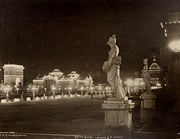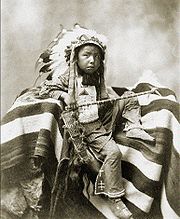
Trans-Mississippi Exposition
Encyclopedia

World's Fair
World's fair, World fair, Universal Exposition, and World Expo are various large public exhibitions held in different parts of the world. The first Expo was held in The Crystal Palace in Hyde Park, London, United Kingdom, in 1851, under the title "Great Exhibition of the Works of Industry of All...
held in Omaha, Nebraska
Omaha, Nebraska
Omaha is the largest city in the state of Nebraska, United States, and is the county seat of Douglas County. It is located in the Midwestern United States on the Missouri River, about 20 miles north of the mouth of the Platte River...
from June 1 to November 1 of 1898. Its goal was to showcase the development of the entire West, stretching from the Mississippi River
Mississippi River
The Mississippi River is the largest river system in North America. Flowing entirely in the United States, this river rises in western Minnesota and meanders slowly southwards for to the Mississippi River Delta at the Gulf of Mexico. With its many tributaries, the Mississippi's watershed drains...
to the Pacific Coast
Pacific Coast
A country's Pacific coast is the part of its coast bordering the Pacific Ocean.-The Americas:Countries on the western side of the Americas have a Pacific coast as their western border.* Geography of Canada* Geography of Chile* Geography of Colombia...
. The Indian Congress
Indian Congress
The Indian Congress occurred from August 4 to October 31, 1898 in Omaha, Nebraska, in conjunction with the Trans-Mississippi International Exposition. Occurring within a decade of the end of the Indian Wars, the Indian Congress was the largest gathering of American Indian tribes of its kind to that...
was held concurrently. Over 2.6 million people came to Omaha to view the 4,062 exhibits during the four months of the Exposition. President William McKinley
William McKinley
William McKinley, Jr. was the 25th President of the United States . He is best known for winning fiercely fought elections, while supporting the gold standard and high tariffs; he succeeded in forging a Republican coalition that for the most part dominated national politics until the 1930s...
and William Jennings Bryan
William Jennings Bryan
William Jennings Bryan was an American politician in the late-19th and early-20th centuries. He was a dominant force in the liberal wing of the Democratic Party, standing three times as its candidate for President of the United States...
were among the dignitaries who attended at the invitation of Gurdon Wattles
Gurdon Wattles
Gurdon Wallace Wattles was an early businessman, banker and civic leader in Omaha, Nebraska who became responsible for bankrolling much of early Hollywood...
, the event's leader. 100,000 people assembled on the plaza to hear them speak. The Expo stretched over a 180 acre (0.7284348 km²) tract in North Omaha and featured a 2000 feet (609.6 m)-long lagoon encircled by 21 classical buildings that featured fine and modern products from around the world.
Timeline

Gurdon Wattles
Gurdon Wallace Wattles was an early businessman, banker and civic leader in Omaha, Nebraska who became responsible for bankrolling much of early Hollywood...
. In making their decision, the committee excluded several sites, including an area near 16th Avenue and Pershing Drive in East Omaha, near the now-dry Florence Lake. It was the preferred site for the Exposition early in 1897. 400 acres (1.6 km²) surrounding the tract that became Miller Park
Miller Park (Omaha, Nebraska)
The Miller Park neighborhood in North Omaha, Nebraska is a historically significant community housing a historic district and several notable historic places. It is located between Sorenson Parkway on the south and Redick Avenue on the north, Florence Boulevard on the east and 30th Street on the west...
was considered the strongest contender towards the middle of the year. However, both sites ended up losing out to a site in North Omaha later in the year when Omaha banker Herman Kountze
Herman Kountze
Herman Kountze was a powerful and influential pioneer banker in Omaha, Nebraska in the late 19th century. After organizing the Kountze Brothers Bank in 1857 as the second bank in Omaha, Herman and his brothers Augustus, Charles and Luther changed the charter in 1863, opening the First National...
donated land in his Kountze Place
Kountze Place
The Kountze Place neighborhood of Omaha, Nebraska is a historically significant community on the city's north end. Today the neighborhood is home to several buildings and homes listed on the National Register of Historic Places. It is located between North 16th Avenue on the east to North 30th...
development to the City of Omaha. After the Expo some of that land would become Kountze Park.
Many important developments happened throughout the city before the opening of the Trans-Mississippi Exposition. They included the opening of the Burlington Train Station
Burlington Train Station
The Burlington Train Station, located at 925 South 10th Street in downtown Omaha, Nebraska is a historically and culturally significant landmark, and is listed on the National Register of Historic Places. When it was opened in 1898, this Italianate style building, designed by Thomas Rogers Kimball,...
in downtown Omaha
Omaha
Omaha may refer to:*Omaha , a Native American tribe that currently resides in the northeastern part of the U.S. state of Nebraska-Places:United States* Omaha, Nebraska* Omaha, Arkansas* Omaha, Georgia* Omaha, Illinois* Omaha, Texas...
. The construction of the hundreds of temporary buildings at the Expo was notable because of the almost exclusive usage of a new, cheap and pliable building material called staff
Staff (building material)
Staff is a kind of artificial stone used for covering and ornamenting buildings.Staff is chiefly made of powdered gypsum or plaster of Paris, with a little cement, glycerin, and dextrin, mixed with water until it is about as thick as molasses, when staff is cast in molds it can form any shape...
. It allowed Expo designers to construct visual reproductions of Grecian and Roman temples, fine European buildings, and more. Thomas R. Kimball designed many of the major buildings at the Expo.
During the Expo, on August 31, 1898, the committee declared "Cody Day" in honor of Buffalo Bill
Buffalo Bill
William Frederick "Buffalo Bill" Cody was a United States soldier, bison hunter and showman. He was born in the Iowa Territory , in LeClaire but lived several years in Canada before his family moved to the Kansas Territory. Buffalo Bill received the Medal of Honor in 1872 for service to the US...
Cody. Cody brought his "world-famous" Wild West Show back to the Omaha Driving Park
Omaha Driving Park
The Omaha Driving Park, later called Sunset Driving Park, was located in North Omaha, Nebraska, USA. It was an important recreational and sports venue in the history of Omaha.- History :...
where it was formally founded several years earlier.
October 12 was "President's Day" at the Expo and featured a speech by President William McKinley
William McKinley
William McKinley, Jr. was the 25th President of the United States . He is best known for winning fiercely fought elections, while supporting the gold standard and high tariffs; he succeeded in forging a Republican coalition that for the most part dominated national politics until the 1930s...
focused on international affairs and the necessity of not being isolationist
Isolationism
Isolationism is the policy or doctrine of isolating one's country from the affairs of other nations by declining to enter into alliances, foreign economic commitments, international agreements, etc., seeking to devote the entire efforts of one's country to its own advancement and remain at peace by...
.
The following year after the Expo some members of its managing committee decided to host another Expo-type event, which became the Great American Exposition in summer 1899.
Commemoration
The Post Office Department issued a series of nine postage stampPostage stamp
A postage stamp is a small piece of paper that is purchased and displayed on an item of mail as evidence of payment of postage. Typically, stamps are made from special paper, with a national designation and denomination on the face, and a gum adhesive on the reverse side...
s to mark the Exposition, each depicting a Western scene. Now known as the Trans-Mississippi Issue
Trans-Mississippi Issue
Black Bull redirects here, for the F-Zero machine, see F-Zero RacersThe Trans-Mississippi Issue, or "Trans-Miss" for short, is a set of nine commemorative postage stamps issued by the United States to mark the 1898 Trans-Mississippi Exposition held in Omaha, Nebraska...
and considered among the finest stamps produced by the US, they are highly prized by collectors; a complete unused set is worth about US$5,000.
A monument to the exposition was placed in Omaha's Kountze Park
Kountze Park (Omaha, Nebraska)
Kountze Park is an urban public park located at 1920 Pinkney Street in the Kountze Place neighborhood of North Omaha, Nebraska, in the United States, and is historically significant as the site of the Trans-Mississippi Exposition of 1898.-About:...
, the former site of the exposition, during a Centennial celebration of the Trans-Mississippi and International Exposition in 1998.
See also
- Richard BockRichard BockRichard W. Bock was an American sculptor and associate of Frank Lloyd Wright.He was particularly known for his sculptural decorations for architecture and military memorials, along with the work he conducted alongside Wright....
- World-famous sculptor who designed several buildings at the Expo.

